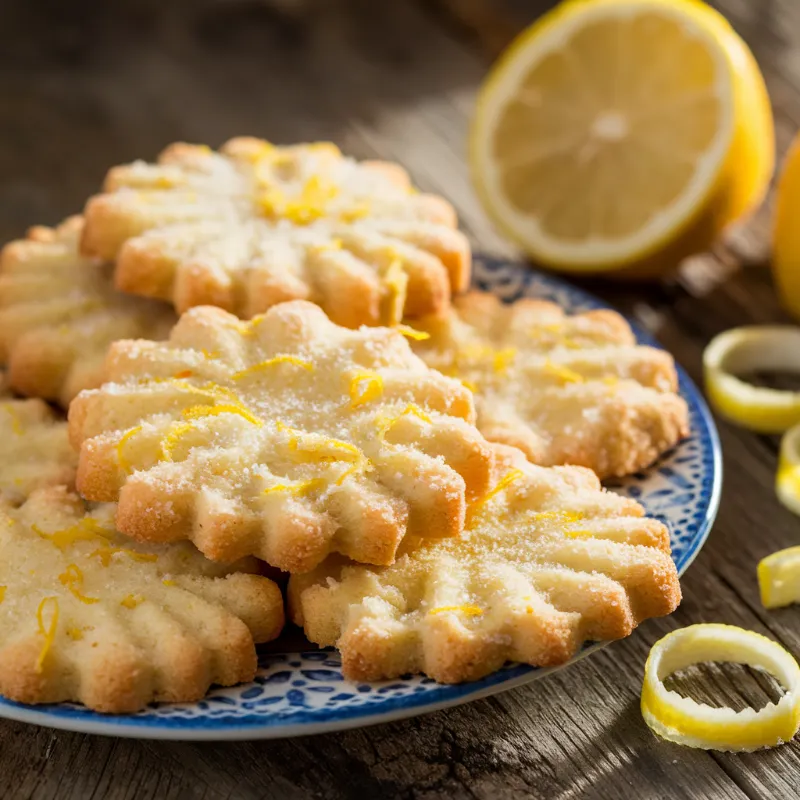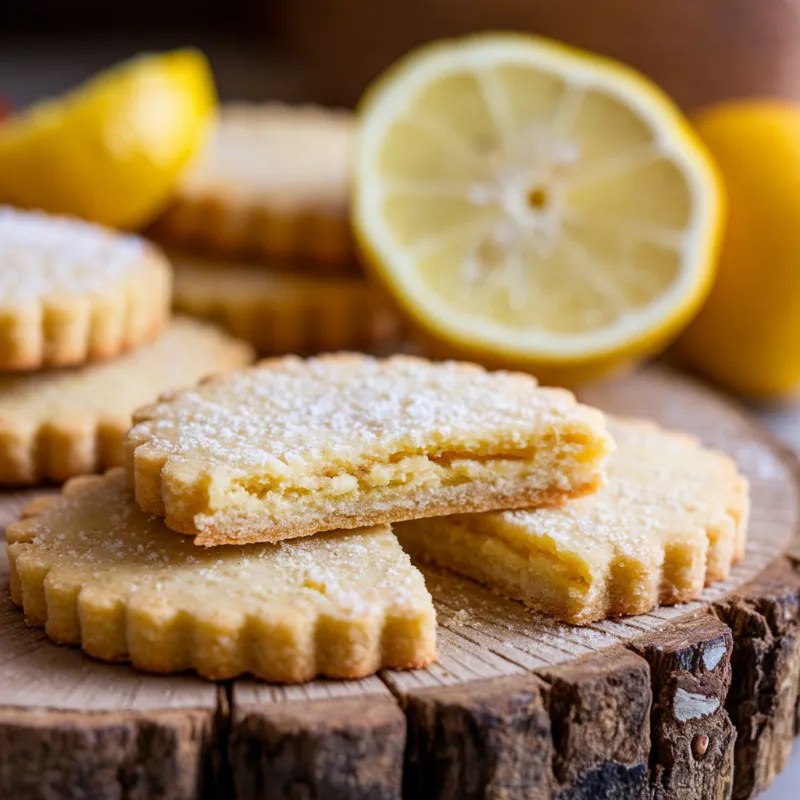There’s something magical about the smell of freshly baked treats wafting through the kitchen. It’s a moment of pure joy, especially when you’re short on time but still want something special. That’s why I’m thrilled to share my lemon shortbread recipe with you. It’s quick, easy, and absolutely delightful!
These buttery bites are tender, crumbly, and bursting with a bright, zesty flavour that’s hard to resist. Whether you’re baking for a cosy afternoon tea or a last-minute gathering, this lemon shortbread is sure to impress. Plus, with just a handful of ingredients, it’s a fuss-free way to satisfy your sweet tooth.
Ready to get started? Let’s dive into this simple yet irresistible treat that’s perfect for any occasion. You’ll be amazed at how effortlessly it comes together!
Table of Contents
Introduction to This Lemon Shortbread Recipe
The journey of perfecting a recipe is as rewarding as the final result. For me, it all started with a lemon tree in my garden. Every year, I eagerly awaited the harvest, knowing those fresh, zesty fruits would inspire something special. This recipe is the culmination of that excitement and countless trials in the kitchen.
From dry biscuits to burnt edges, I’ve faced it all. But each mistake taught me something new. I experimented with different ratios of butter, flour, and sugar, and even tried vegan and gluten-free alternatives. Yet, the classic version always stood out for its simplicity and sophisticated flavour.
Background and Inspiration
Planting that lemon tree was more than just a gardening project. It became a symbol of patience and creativity. The first time I used its fruit in baking, I knew I had to create something extraordinary. The bright, tangy aroma of lemon zest paired with the richness of butter was a match made in heaven.
Why This Recipe Stands Out
What makes this recipe exceptional is its balance. It’s quick to prepare, taking just 15 minutes to mix the dough, yet it delivers a flavour that feels indulgent. The combination of simple ingredients and a touch of citrus creates a treat that’s both comforting and refreshing.
| Ingredient | Role |
|---|---|
| Butter | Adds richness and a crumbly texture |
| Lemon Zest | Provides a bright, zesty flavour |
| Flour | Forms the base of the dough |
Whether you’re a seasoned baker or a beginner, this recipe is designed to bring joy to your kitchen. It’s a testament to the beauty of simplicity and the power of a personal touch.
Ingredients: The Key to a Flavourful Experience
Every great bake starts with the right ingredients. In this section, we’ll explore the essential components that make these treats so special. Each element plays a crucial role in achieving that perfect balance of buttery richness and zesty brightness.
Essential Ingredients and Their Roles
Let’s break down the key ingredients and their contributions:
| Ingredient | Role |
|---|---|
| High-quality butter | Adds richness and a crumbly texture |
| All-purpose flour | Forms the base of the dough |
| Cane sugar | Provides sweetness and helps with browning |
| Fresh zest | Delivers a bright, tangy flavour |
| Sea salt | Enhances the overall taste |
Using ½ cup of butter and ⅓ cup of sugar ensures the dough has the ideal texture. Whisking the sugar with the butter, along with a tablespoon of fresh zest, creates a fragrant and flavourful base.
Don’t forget the importance of chilling the dough for at least 3 hours. This step ensures the cookies hold their shape during baking. With these ingredients and a little time, you’ll achieve a treat that’s both tender and tangy.
Step-by-Step Preparation Process
Preparing the dough is where the magic truly begins. It’s a process that combines precision with creativity, ensuring every bite is perfect. Let’s walk through each step to make sure your cookies turn out just right.
Creaming, Mixing and Forming the Dough
Start by creaming the butter and sugar together until light and fluffy. This step is crucial for achieving that rich, crumbly texture. Add a tablespoon of lemon juice and fresh zest to infuse the dough with a bright, tangy flavour.
Next, gradually mix in the flour until the dough comes together. Be careful not to overmix, as this can make the cookies tough. Once combined, shape the dough into a disc, wrap it in cling film, and chill for at least 3 hours. This helps the dough firm up, making it easier to handle.
Rolling Out and Cutting the Dough
When the dough is ready, roll it out on a clean, well-floured surface. Aim for a thickness of about ¼ inch to ensure even baking. Use your favourite cookie cutters to create shapes, and don’t forget to re-roll the scraps to maximise your yield.
Place the cut-out shapes on a baking sheet lined with parchment paper. This prevents sticking and makes cleanup a breeze. Handle the dough with care to maintain its shape and texture. With these steps, you’re well on your way to creating delicious, golden cookies.
| Step | Key Tip |
|---|---|
| Creaming Butter and Sugar | Mix for at least 3 minutes for a light texture |
| Adding Lemon Juice | Use fresh juice for the best flavour |
| Rolling the Dough | Keep the surface well-floured to prevent sticking |
| Cutting Shapes | Re-roll scraps to maximise yield |

Baking Techniques and Oven Tips
Baking is both an art and a science, and mastering the oven is key to perfect results. Whether you’re a seasoned baker or just starting out, these tips will help you achieve that golden, crumbly texture every time.
Preheating and Temperature Settings
Always preheat your oven to 170°C (340°F) before baking. This ensures even heat distribution, which is crucial for consistent results. If your oven runs hot or cold, consider using an oven thermometer to monitor the temperature accurately.
For best results, bake your treats on the middle rack. This allows for even airflow and prevents over-browning on the top or bottom. Remember, a minute or two can make a big difference, so keep an eye on the edges for that perfect crunch.
Chilling and Timing Essentials
Chilling the dough for at least 3 hours is essential. It firms up the dough, making it easier to handle and preventing excessive spreading during baking. If you’re short on time, you can chill it for 1 hour, but longer is better for optimal texture.
When working with ingredients, ensure they’re at room temperature. This helps the dough come together smoothly and ensures even baking. Cold butter or eggs can lead to uneven textures.
Use parchment paper to line your baking sheet. It prevents sticking and makes cleanup a breeze. Plus, it helps the cookies bake evenly without burning the bottoms.
Finally, monitor your bake closely. The edges should be lightly golden, and the centres should feel set but not hard. Overbaking can lead to a dry texture, so trust your instincts and remove them just in time.

Lemon Shortbread
Ingredients
Equipment
Method
- In a mixing bowl, cream the butter and sugar together until light and fluffy (about 3 minutes).
- Add the lemon zest and lemon juice, mixing until combined.
- Gradually mix in the flour and sea salt, stirring until a dough forms.
- Shape the dough into a disc, wrap it in cling film, and chill in the refrigerator for at least 3 hours.
- Preheat the oven to 170°C (340°F) and line a baking sheet with parchment paper.
- On a floured surface, roll out the dough to ¼-inch thickness and cut into desired shapes using cookie cutters.
- Place the cookies on the prepared baking sheet and bake for 10-12 minutes, or until the edges are lightly golden.
- Allow to cool on the baking sheet for a few minutes before transferring to a wire rack to cool completely.
Creating something special in the kitchen is always a joy, especially when it’s as simple as this. Every step, from blending vanilla to adding a touch of citrus, leads to a treat that’s both tender and flavourful. The process is straightforward, yet the result feels indulgent.
For a creative twist, experiment with different shapes or add a bit more zest to enhance the citrus notes. Serving these with a cup of tea or a drizzle of icing can elevate the experience, making it perfect for any occasion.
I encourage you to try this at home and share your own tweaks. Baking is all about making it your own, and I’d love to hear how you’ve personalised it. Enjoy your homemade treats with confidence—they’re sure to impress!
Frequently Asked Questions:
What is the secret to making good shortbread?
The key to perfect shortbread is high-quality butter, precise mixing, and the right baking temperature. Using good-quality, high-fat butter (such as European-style butter) ensures a rich flavor and tender texture. The dough should be mixed just until combined—overworking it develops gluten, making the shortbread tough. Chilling the dough before baking helps retain its shape and enhances the texture. Baking at a low temperature (300–325°F / 150–160°C) allows for even cooking, preventing browning and ensuring a delicate, crumbly texture.
What are common mistakes when making shortbread?
1. Overmixing the dough – This develops gluten, making the shortbread tough instead of crumbly.
2. Using warm butter – Soft or melted butter can make the dough greasy, affecting the texture.
3. Not chilling the dough – This can cause spreading and loss of shape.
4. Overbaking – Shortbread should be pale golden, not browned, as overbaking makes it too hard.
5. Incorrect flour-to-butter ratio – Too much flour results in dry, crumbly shortbread, while too much butter makes it greasy.
What is the difference between Scottish shortbread and shortbread?
Scottish shortbread is a traditional variation of shortbread that is often made with coarse-ground flour, like oat flour, and more butter, giving it a denser, richer, and slightly crumblier texture. Regular shortbread typically uses all-purpose flour and may include small amounts of cornstarch or rice flour for a lighter texture. Some versions of regular shortbread also incorporate vanilla or lemon zest for added flavor.
What happens if you don’t chill shortbread before baking?
Skipping the chilling step can lead to spreading, making the cookies thinner and losing their intended shape. The butter in the dough needs to be firm before baking to ensure the classic crumbly texture. Without chilling, the cookies may also bake unevenly, resulting in a tougher or greasy texture.
Should butter be cold when making shortbread?
Butter should be softened but not melted. Cold butter makes it harder to mix the dough evenly, while melted butter creates a greasy texture. The ideal consistency is room temperature (around 65°F / 18°C), where the butter is soft but still holds its shape.
Why use powdered sugar in shortbread?
Powdered sugar (icing sugar) creates a tender, melt-in-the-mouth texture because it dissolves more easily than granulated sugar. It also reduces gluten formation, keeping the shortbread soft and crumbly rather than chewy.
